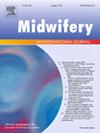Pulled in different directions – The experiences of birth partners and care-providers when supporting women to implement what they learn in childbirth education classes
IF 2.6
3区 医学
Q1 NURSING
引用次数: 0
Abstract
Background
Childbirth education (CBE) is often viewed as a singular intervention separate from the broader maternity system, meaning differences in effectiveness are attributed solely to the program delivered. Understanding the impact support people have on the translation of CBE techniques using Bowen theory as a wider systems-based lens, could offer important insights into the utilisation and effectiveness of CBE techniques.
Aim
To examine how the functioning of birth partners and care-providers during labour, impacts the use of CBE strategies employed by women.
Methods
In-depth, semi-structured interviews with 11 birth partners; and two focus groups with 12 care-providers, examined their experiences of supporting CBE techniques. Bowen family systems theory concepts were used as a guide for deductive analysis.
Findings
Interpersonal and systemic pressures presented a challenge to maintaining CBE strategies, captured in the over-arching theme ‘Pulled in different directions’. Support in using CBE strategies transitioned along two continuums; ‘Positioned with self or other’ and ‘Dominance of thoughts or emotions’, highlighting the challenge of balancing supportive encouragement for CBE with pressure that limits their application.
Discussion
Birth partners and care-providers are well positioned to help women utilise CBE techniques, but various factors impact their ability to do so. These factors largely relate to systemic pressures that impact inter-personal relations and subsequent individual responses.
Conclusion
While birth partners and care-providers aim to support the use of CBE techniques, maternity system level factors leave them feeling ‘pulled in different directions’. This impacts their capacity to continue supporting their use throughout labour.
被拉向不同的方向——生育伴侣和护理人员在支持妇女实施她们在分娩教育课程中学到的知识时的经验
分娩教育(CBE)通常被视为与更广泛的产妇系统分离的单一干预,这意味着有效性的差异完全归因于所提供的计划。将鲍文理论作为一个更广泛的基于系统的视角来理解人们对CBE技术翻译的影响,可以为CBE技术的利用和有效性提供重要的见解。目的研究生育伙伴和护理提供者在分娩过程中的作用如何影响妇女使用CBE策略。方法对11名生育伴侣进行半结构化深度访谈;以及由12名护理人员组成的两个焦点小组,调查了他们支持CBE技术的经验。Bowen家族系统理论概念被用作演绎分析的指导。人际和系统压力对维持CBE战略提出了挑战,这体现在“拉向不同方向”的总体主题中。支持使用两个连续体过渡的CBE策略;“以自我或他人为中心”和“主导思想或情感”,突出了平衡对CBE的支持鼓励与限制其应用的压力的挑战。生育伴侣和护理人员有能力帮助妇女利用CBE技术,但各种因素影响了他们的能力。这些因素在很大程度上与影响人际关系和随后的个人反应的系统性压力有关。结论虽然生育伴侣和护理人员的目标是支持使用CBE技术,但产科系统层面的因素使他们感到“被拉向不同的方向”。这影响了他们在整个劳动过程中继续支持使用的能力。
本文章由计算机程序翻译,如有差异,请以英文原文为准。
求助全文
约1分钟内获得全文
求助全文
来源期刊

Midwifery
医学-护理
CiteScore
4.50
自引率
7.40%
发文量
221
审稿时长
13.4 weeks
期刊介绍:
Midwifery publishes the latest peer reviewed international research to inform the safety, quality, outcomes and experiences of pregnancy, birth and maternity care for childbearing women, their babies and families. The journal’s publications support midwives and maternity care providers to explore and develop their knowledge, skills and attitudes informed by best available evidence.
Midwifery provides an international, interdisciplinary forum for the publication, dissemination and discussion of advances in evidence, controversies and current research, and promotes continuing education through publication of systematic and other scholarly reviews and updates. Midwifery articles cover the cultural, clinical, psycho-social, sociological, epidemiological, education, managerial, workforce, organizational and technological areas of practice in preconception, maternal and infant care.
The journal welcomes the highest quality scholarly research that employs rigorous methodology. Midwifery is a leading international journal in midwifery and maternal health with a current impact factor of 1.861 (© Thomson Reuters Journal Citation Reports 2016) and employs a double-blind peer review process.
 求助内容:
求助内容: 应助结果提醒方式:
应助结果提醒方式:


